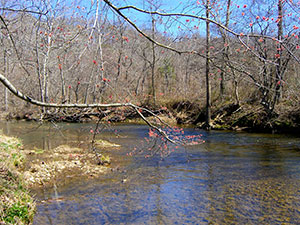
When James and Karen Allen placed their Flint Hill property under a conservation easement this August, they protected over 100 beautiful acres of scenic open space and viable farmland; over 4,000 feet of the Jordan River; and more than 1,600 feet of front-age on Zachary Taylor Highway—one of Virginia’s Scenic Byways.
These accomplishments are important individually but this new easement is also a part of a much larger success story. This land is now a patch in a quilt of protected lands distributed throughout Rappahannock and the Piedmont. The Allens have joined a historic rank of conservationists who have put their love for this region into action by donating a conservation easement.
“We put our property under easement to protect its natural beauty and rural character for generations to come,” Karen Allen explains. “Once land is developed, it is lost to conservation forever. Easements help to prevent the gradual nibbling away of our precious scenic open land.”
The Allens’ easement adjoins 17 other easements, including two additional easements granted on the Jordan River this year: a 51-acre easement donated by Karen Allen’s brother, Lawrence Vierling, and his wife Sandy; and a 93-acre easement granted by Helen Dubois. Together, these three easements protect about two more miles of the Jordan River. In total, there are now nearly five miles of protected riparian buffer on the river as it meanders from Rt. 522 to its junction with the Rappahannock River.
These easements provide healthy habitat and viable corridors for many species of wildlife, as well as protect important farmland and forest. They will also help to ensure clean water for our neighbors downstream—including all of those who call the Chesapeake Bay home.
Rappahannock’s Comprehensive Plan states that the County should “recognize the County’s rivers as one of the most significant environmental resources and provide for their protection.” Since the first easement in Rappahannock 1974, residents have continued to step up to protect the natural and cultural resources that form the backbone of our community—for this generation and the next.
